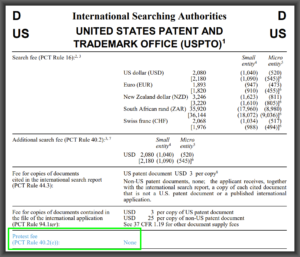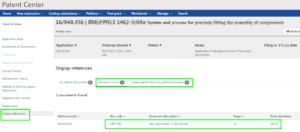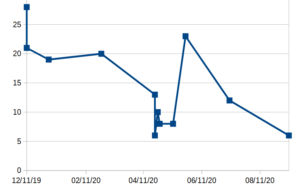When the USPTO made Patentcenter available for alpha testing about two years ago, I was one of the alpha testers. As an alpha tester, I reported bug after bug to the USPTO. But I did not criticize the USPTO publicly. I was a good alpha tester, reporting the bugs only privately to the USPTO.
This went on for a year, and then USPTO quietly shifted from alpha testing to beta testing, and it meant that more users got added to the pool of testers. The beta testing was also a closed environment, just like the alpha testing. I was a good beta tester, continuing to report bugs only privately to the USPTO.
I think it is possible that my firm was the most diligent and prolific alpha- and beta-tester of Patentcenter during the closed alpha and closed beta testing phases. What makes me think this is:
- It appears that by the end of 2019, my firm had filed fully half of all of the entries into the US national phase from a PCT application that anybody had filed in Patentcenter (blog article).
- It appears that by April of 2020, my firm had filed at least eight percent of all of the utility patent applications that anybody had filed in Patentcenter (blog article).
- It appears that by April of 2020, my firm had filed at least half of all of the design patent applications that anybody had filed in Patentcenter (blog article).
To the USPTO’s credit, it did fix perhaps one-third of the bugs that alpha- and beta-testers reported. But even now, two years later, many bugs that alpha- and beta-testers have reported to the USPTO have not gotten fixed.
This would not be so bad except that a few months ago the USPTO decided to release Patentcenter for beta testing by the general public. Anybody who wishes may now make use of Patentcenter.
And so as of that time I felt there is no need to keep bug reports private. I set up the Patentcenter listserv, which is an email discussion group for beta testers of Patentcenter. I set up the Patentcenter trouble ticket web site.
What is disappointing is that many Patentcenter bugs that have been reported to the USPTO since it released Patentcenter for beta testing by the public have not been fixed. What is even more disappointing is that many Patentcenter bugs reported a year ago or even two years ago by beta- and alpha-testers have not been fixed.
Here is one example among dozens.
When you upload a PDF as part of your e-filing activity, your natural expectation about it might be:
If you upload it, and if you preview it in the e-filing system, and if it looks the way it is supposed to look, then you can safely click “submit” and it will look that way in IFW.
In ePCT, this is indeed how it works. If it is going to get degraded when you click “submit”, then the preview will show you what the degraded file would look like. This gives you fair warning. You can then set to work trying to figure out what to do differently so that the file will not get degraded so badly.
In Patentcenter, this is not how it works. A file containing gray scale might look perfectly normal to the human eye when previewed in Patentcenter. But it will get degraded badly after you click “submit”, and it might get degraded to the point of being unreadable.
Not only that, Patentcenter might convert it into blank pages.
I am not making this up. Blank pages. The preview will show normal pages that are not blank. And when you click “submit”, what will later turn up in IFW might be blank pages.
One thing that this means is that to protect yourself from malpractice liability when using Patentcenter, you have no choice but to go into IFW after you have e-filed a document, to view it and to see whether it has gotten converted into blank pages. And to see whether it has gotten blurred or degraded, perhaps to the point of unreadability.
This is not easy to do if, as has very often happened in recent weeks, you cannot see it at all in IFW until a day or two after the day that you e-filed it.
Which brings me to my disappointment at USPTO’s failure to attend to bugs that are being reported these days by the listserv community. Take a look at bug number CP27 . This bug is the problem of Patentcenter converting a perfectly readable PDF file into blank pages. This bug got reported to the USPTO on June 8, 2020. I blogged about it on June 8, 2020. Three weeks passed with no corrective action by the USPTO, so one of the listserv volunteers (Richard Schafer) cross-posted the bug report into Ideascale (direct link) on July 4, 2020. Nobody from USPTO has responded in any way to this posting in Ideascale.
What prompted this blog posting today is a disappointing thing that happened yesterday when I e-filed a new patent application in Patentcenter. This time I got lucky and I was able to see the newly filed application in IFW right away instead of having to wait several days for it to be visible in IFW. And I was astonished to see that the USPTO had still not corrected the defect in Patentcenter that Patentcenter sometimes converts a PDF into blank pages.
Months have passed since this extremely serious bug got reported to the USPTO, and it has not been attended to even now.
As I say, in this case I got lucky. Instead of having to wait several days for the newly filed application to be visible in IFW, I was able to see this application right away in IFW. I clicked through the 120 or so pages of what I just e-filed, to see what damage Patentcenter had done to the various files that I had uploaded. Yes, many files were degraded but most of the degradations were modest enough to permit the pages to continue to be human readable. But three pages had gotten converted to blank pages. I then located the source PDF document and printed it to CutePDF and uploaded it and e-filed it again. This time Patentcenter did not convert it to blank pages. Because I was able to deal with this malfunction in Patentcenter on the same day that Patentcenter malfunctioned, I did not need to worry about losing a filing date due to the malfunction in Patentcenter.
But what is so very disappointing is that USPTO has seemingly paid no attention to this extremely serious bug report, even after some three months.





 In the PCT listserv, a practitioner recently exasperatedly asked:
In the PCT listserv, a practitioner recently exasperatedly asked:
